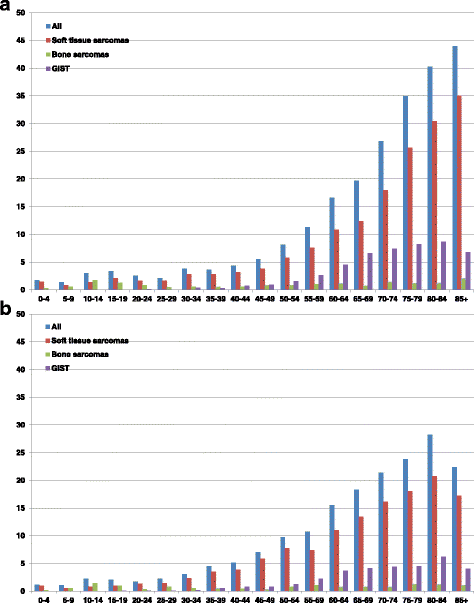Strengthening health data on a rare and heterogeneous disease: sarcoma incidence and histological subtypes in Germany
- PMID: 29433465
- PMCID: PMC5809940
- DOI: 10.1186/s12889-018-5131-4
Strengthening health data on a rare and heterogeneous disease: sarcoma incidence and histological subtypes in Germany
Abstract
Background: The population-based incidence of sarcoma and its histological subtypes in Germany is unknown. Up-to-date information on a disease with an incidence comparable to other cancer entities is of high public health relevance. The aim of this study was to determine this incidence and to detect significant changes in incidence trends using data from German epidemiological cancer registries.
Methods: Pooled data from the German Centre for Cancer Registry Data with a primary diagnosis occurring in 2013 were used. To date, this is the latest data on cancer incidence available for Germany. All German cancer registries with sufficient completeness were included (10 out of 11), covering a population of 70.0 million people, representing 87% of the German population. All malignant sarcomas according to the RARECARE Project and the WHO classification 2002 were considered for analysis and, above all, gastrointestinal stromal tumours (GIST) of uncertain behaviour. Sensitivity analysis was performed excluding certain histologies.
Results: The analysis included 3404 cases in men and 3442 cases in women diagnosed in 2013. The age adjusted sarcoma incidence (European standard) was 7.4 (men) and 6.6 (women) per 100,000 inhabitants. About 70% of sarcomas were soft tissue sarcomas, about 22% GIST, and about 9% bone sarcomas. The most common histological subtypes besides GIST were fibrosarcomas (14%) and liposarcomas (12%) in men and complex mixed and stromal neoplasms (22%), non-uterine leiomysarcomas (10%) and fibrosarcomas (9%) in women. Considering the trend for the years of diagnosis 2004 to 2013, there was a significant increase in incidence for GIST while the incidence of soft tissue sarcomas (only men) as well as of bone sarcoma stayed constant over time. As to soft tissue sarcoma in women, the incidence stayed constant up to the year 2009 and significantly decreased afterwards.
Conclusion: This study is the first detailed analysis of a German-wide population-based sarcoma incidence showing results comparable to the incidence detected in the RARECARE Project.
Keywords: Gastrointestinal Stromal tumours; Germany; Histology; Incidence; Neoplasms; Sarcoma; Topography, Medical.
Conflict of interest statement
Ethics approval and consent to participate
Not applicable
Consent for publication
Not applicable
Competing interests
The authors declare that they have no competing interests.
Publisher’s Note
Springer Nature remains neutral with regard to jurisdictional claims in published maps and institutional affiliations.
Figures


References
-
- Fletcher CDM, Uni KK, Mertens F, editors. WHO classification of Tumours. Pathology and genetics of Tumours of soft tissue and bone. Lyon: IARC Press. –2002.
-
- Borden EC, Laurence HB, Bell RS, Bramwell V, Demetri GD, Eisenberg BL, et al. Soft tissue sarcomas of adults: state of the translational science. Clin Cancer Research. 2003;9(6):1941–1956. - PubMed
-
- Gatta G, van der Zwan JM, Casali Paolo G, Siesling S, Dei Tos AP, Kunkler I, et al. Rare cancers are not so rare: the rare cancer burden in Europe. Eur J Cancer 2011. 2011;47(17):2493–2511. - PubMed
-
- Toro J, Travis LB, Wu HJ, Zhu K, Fletcher CDM, Devesa SS, et al. Incidence patterns of soft tissue sarcomas, regardless of primary site, in the surveillance, epidemiology and end results program, 1978-2001: an analysis of 26,758 cases. Int J Cancer. 2006;119:2922–2930. doi: 10.1002/ijc.22239. - DOI - PubMed
MeSH terms
LinkOut - more resources
Full Text Sources
Other Literature Sources
Medical
Research Materials

